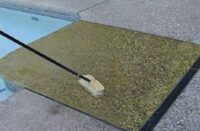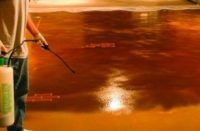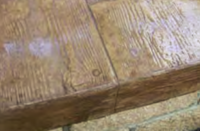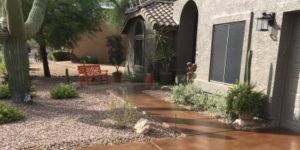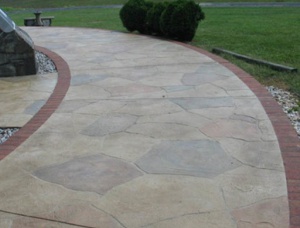
Comparing a concrete sealer to the frosting on a cake may sound a bit frivolous, but they actually do have some things in common. Frosting makes the cake look better and keeps it fresh longer. Sealers make decorative concrete look better and keep it looking good and performing well longer. No baker would serve a birthday cake without frosting. Thusly, no experienced concrete contractor would install a decorative floor without a sealer.
So if appearance and protection are the basic expectations for a sealer, what factors should be considered in choosing the right product for a given application? Clifford Platt, vice president of Vexcon Chemicals Inc., names three basic ones. First, environment. He recommends asking: “What environment will the sealer be asked to perform in? Indoors or outdoors? Wet or dry? What part of the country?” Second, traffic. “Vehicle traffic is going to cause the coating to wear sooner than foot traffic,” he says. “And will there be chemical exposure such as gas or oil?” Third, maintenance. “Are they going to be able to recoat every few years to keep the sealer looking good and protect the decorative concrete?”
Considerations when sealing concrete
Bob Harris, president of the Decorative Concrete Institute, names several considerations specific to contractors and application requirements. “Cost, dry times, availability and whether the product is solvent- or water-based are important factors,” he says.
Shellie Rigsby, owner of ConcreteStainDesigns.com, says the level of slip resistance required is a factor in choosing a sealer. “Different areas and projects have different code requirements,” she says. “Make sure the product you install meets or exceeds code.”
One factor that is often overlooked when sealing decorative concrete floors is humidity mitigation. This is according to Mike Hernandez, owner of ReUse Concrete Sealing Specialists LLC, based in Overland Park, Kan. “We have seen beautiful decorative floors ruined in a matter of months because of moisture coming up through the substrate,” he says. This moisture can come when concrete is colored and sealed too soon or in below-grade applications where moisture from the underlying soil is continually transmitted. He recommends testing for humidity and acidity in order to select a sealer with the right pH balance and vapor transmission capabilities for avoiding trapping moisture between the colored surface and the sealer.
Penetrating or film-forming?
Most sealers fall into one of two broad categories — penetrating or film-forming. Penetrating sealers are primarily silicone solids suspended in a fluid carrier. They penetrate concrete pores and deposit the silicone into them, leaving virtually no film build. However, they typically won’t repel stubborn oil or grease stains as well as film-forming sealers do.
“For regular concrete, we recommend a penetrating, chemically reactive siliconate sealer,” Hernandez says. “These sealers are the top of the line in our opinion. Siliconate sealers react with the lime in the concrete to create a bond and fill the open pores. They ‘glassify’ the surface anywhere from 1 mil to 4 mils deep to protect against moisture penetration. Penetrating sealers are especially effective protecting against damage in areas prone to freeze-thaw cycles.”
Hernandez doesn’t use penetrating sealers for colored concrete floors. “Penetrating sealers last longer than film-forming, but leave the surface vulnerable to stains, as all of the sealer is inside the concrete,” he says. “These sealers are primarily intended for outdoor concrete such as driveways and sidewalks.”
Generally, film-forming sealers are preferred for decorative concrete. “For stamped concrete, a film-forming sealer is a must,” Platt says. “Otherwise the antique look will begin to degrade immediately. In addition, a film-forming sealer enhances the colors below it far better than penetrating sealers. Stained concrete can be sealed with either type, but film-forming sealers do a better job of bringing out the depth of the colors in acid stains, dyes and colored concrete.”
Water-borne vs. solvent
Another significant distinction is between water-borne and solvent-borne sealers. Odor is the major argument against using solvent-based sealers indoors, according to Hernandez. “Solvent-based acrylic sealers create an odor inside that is absolutely unbearable,” he says. “Many people have to move out of their homes while they are applied. This is because the fumes can create headaches, nausea, shortness of breath and other symptoms. Also, the fumes are highly flammable and even a spark can ignite them.”
With little or no emissions of volatile organic compounds, water-based sealers are preferred in regions with stringent VOC regulations and by customers and contractors who want a “green” product. “Depending on the project, an architect may be looking for products eligible for LEED points,” Platt says. “The contractor will have to be careful that the manufacturer’s product meets these requirements and can provide the supporting paperwork required.”
Solvent-based sealers offer some advantages of their own. “We have used solvent-based as well as water-based acrylic sealers,” Hernandez says, “and the solvent-based sealers appear to be more durable when used on outside concrete.” They also tend to have a more dramatic impact on the color of decorative concrete and can be used to achieve varied decorative effects.
Rigsby adds one other caution when using a solvent-based sealer outside. “As a solvent-based sealer cures, it releases oils that rise to the top, which can make the concrete slippery when wet,” she says. “Customers need to watch for this and clean it off with a hose and broom. This is not usually a long-term issue.”
Compatibility with finishes
“As a general rule, it is a good idea to try and stick with a certain manufacturer’s complete system,” Harris recommends. “If this can’t be done because the manufacturer does not have a certain product, it is a good idea to call them to make sure there are no compatibility issues. Also, find out what kind of preparation the floor needs prior to applying the sealer or coating.”
Most sealers work on acid-stained floors. “I let the environment and the client dictate what sealer to use,” Harris says. “For example, if it is the interior of their own home and odor is an issue, maintaining water-based acrylic sealer with floor wax is fine. If it is a commercial hotel in Las Vegas, epoxy with polyurethane would be the system to use.” He says the same considerations apply to a water-based stain.
When it comes to stamped concrete, most installers use either water-based or solvent-based acrylics, Harris says. Also, some are using methyl methacrylate (MMA) sealers designed specifically for this application.
The choice of sealer for stamped concrete may depend on the pattern — does the customer want a wet look or something closer to natural stone? For a wet look, Platt says, the higher the solids content, the greater the gloss. “Typically 30 percent solids is the minimum requirement. Some products are available with 35 percent.” Harris adds: “Solvent-based acrylics, 100 percent solid epoxies, gloss polyurethanes and polyaspartics all provide what is referred to as the wet look. In turn, it darkens the concrete color and providing a high sheen.”
For a natural stone look, Platt says, choose a film-forming coating that has a matte or flat finish. “You could also use a fully penetrating sealer that will leave the natural look of the surface unchanged.”
Decorative sealing
Sealers do not just protect decorative concrete. They can enhance or deepen the color and add gloss to the finished project. Some contractors are taking sealers to the next level. They do this by using them in concert with coloring techniques to create unique decorative finishes.
For example, Mike Hernandez has found a creative use for a coating that protects against moisture vapor transmission. He applies it in a variegated pattern to replicate the look of acid stain. “We have used this process extensively in basements with humidity issues,” he says.
Concrete artisan Shellie Rigsby of Plano, Texas, works with sealers the way an artist works with paint, using different materials and pigments. For example, she might use two different sealers over the same colored floor to accent certain features. “When you have to cut a line around the perimeter of a room, you can put a water-based sealer on one side (of the line) and a solvent-based sealer on the other. So now you make that feature stand out as a trim piece,” she says. “You can try the same thing with different color stains, but simply changing the sealer can make darker or lighter shades of the same color.”
Don’t be shy about color
Rigsby is also not shy about adding color to sealers. She will spike her sealers with pigments, dyes, and even universal tints for solvent-based paint.
Besides adding color and interest, a pigmented sealer can correct problems, she says. “A deep terra cotta stain sometimes comes out orange — a bright orange rust color. But if you add a little black to your sealer it will play down that color.”
Rigsby cautions that the dye one chooses must be UV-stable, as the UV inhibitor in a sealer will not be enough to protect the color of the dye. Also, a pigment must be suspended in the sealer in order to get a translucent depth effect.
Hernandez advises contractors to be cautious in general when experimenting. “Adding pigments to sealers is not always effective. This is because the pigments tend to float and rise to the top. The color is then left unprotected,” he says. “Only pigments that were designed to go in the sealer should be used.”
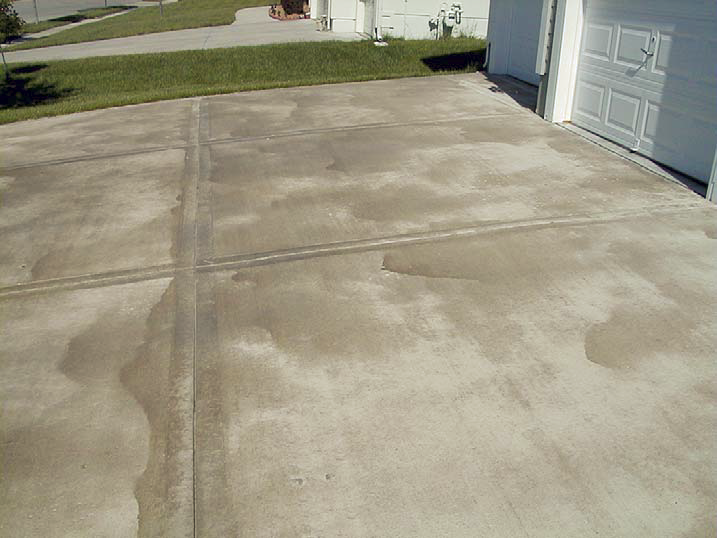
Protecting the concrete investment
In order for the sealer to provide the best appearance and long-lasting protection, it must be applied properly and maintained regularly.
Many problems arise with improper sealer application, says Hernandez. One can etch the concrete by using too small of a tip. Additionally, adding too much water pressure, or being too close to the concrete when cleaning it to prepare it for sealing can etch the concrete. Other problems include spraying on acrylic sealers too heavily. This creates wave patterns or stained areas in the concrete, putting two different types of sealer on the same driveway and creating two different looks, and putting a water-based sealer over a solvent-based product and having the sealer peel off. Sometimes sealers remain tacky or discolor the floor below if you apply the wrong sealer for the moisture level of the concrete, he adds.
“Overapplication and applying on very hot days and in direct sunlight are the most common problems we see,” Platt says. These and other poor techniques, such as improper surface preparation or inadequate curing, result in delamination, turning white, air bubbles, cloudiness and cracking, notes Harris.
In conclusion
Even with proper application, sealers maintenance must occur and surfaces resealed. “Most of the time customers think the color is fading on their decorative concrete. It might be that all that is happening is that the sealer is breaking down and needs to be redone,” Hernandez says.
“If the project is outside, then the final sealer coat is the wear coat, the sacrificial coat,” Rigsby advises. “Plan to inspect the sealer every six months and reapply each year. Just think, it’s time to plant the flowers and seal the driveway.”
Indoors, she recommends applying a floor finish or wax on top of the sealer. Again, this final topcoat is the sacrificial coat. “There is no such thing as a maintenance-free floor,” she says. “Sealers are no exception.”
Questions from Readers
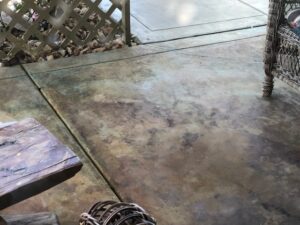
Question
I acid stained my front porch with 3 different colors. Now it’s time to seal. What kind of sealant should I use? We live in the desert in Palm Springs, Calif., where it gets over 100 degrees a lot.
Answer from Concrete Decor
The staining looks great. Nice job!
We recommend using a water-based sealer (WB) as it goes on milky (helps to ensure even coverage) but dries clear. It also will have no problem dealing with those hot daytime temps. Just make sure you seal it during the cool of the day (or night) so the sealer isn’t drying too fast.
Note that a solvent-based sealer will bring out more of the color in the staining application, but some VOC laws in your state may limit your use of various types of materials.
You can check out a number of Concrete Sealers on the Concrete Decor Store website.
